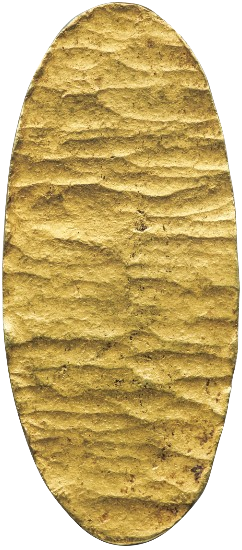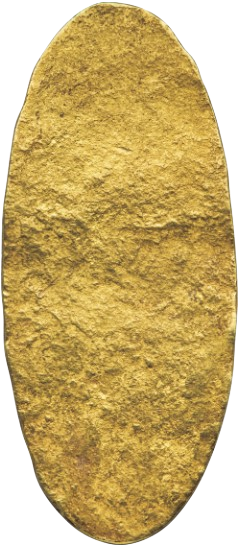Hirumokin (蛭藻金)


(Ginza Coins Collection, Tokyo. Reproduction authorized. © All rights reserved.)
The Hirumokin represent a significant chapter in the history of Japanese coinage. Minted between 1501 and 1588, during a period of political transition and military unrest, these gold coins take their name from their resemblance to the leaves of the aquatic plant hirumo. Produced using advanced casting and engraving techniques, they were created by hammering gold sheets against stone until the desired shape was achieved. While similar in appearance to the better-known Ōban, Hirumokin were smaller and likely held lower monetary value. They are distinguished by their elongated shape and smooth surface, sometimes engraved with distinctive symbols upon request from local lords. The lack of standardization is evident in the variation in weight (up to 140 grams) and length (110–116 mm). Historical information remains limited, adding to the mystery surrounding these coins. In 1971, an archaeological discovery in Kōfu (Yamanashi Prefecture) uncovered numerous examples of Hirumokin and gold ingots, confirming the region's connection to Takeda Nobutomo, a key figure in the earliest phases of Japanese gold coinage.
| Coin Name | Hirumokin |
| Japanese Inscription | 蛭藻金 |
| Historical Period | Sengoku Period (1467–1603 AD) |
| Year of Minting | 1501 – 1588 d.c. |
| Chronological Reference | Unspecified |
| Minting Location | Unspecified |
| Issuing Authority | Not definitively established |
| Function | Effective coinage (used for both commercial transactions and symbolic purposes, associated with local authority) |
| Material | Gold |
| Shape | Elongated |
| Height | 11 – 11.6 cm |
| Width | 4.5- 5.2 cm |
| Weight | 115 – 140 g |
| Manufacturing Technique | Manually executed casting and striking performed on stone surfaces |
| Obverse Text and Symbols | At times featuring symbolic, non-standardized engravings |
| Reverse Text and Symbols | None |
| Calligrapher / Artist: | Unspecified |
| Museum References | Tokyo National Museum E-20082 Currency Museum Bank of Japan ⅡAカマb1/5 |
| Number of Known Specimens | A considerable number of specimens are known, although not quantified with precision; a particularly important discovery occurred in Kōfu in 1971 |
References and Bibliography
The Gold of Tokugawa, Alberto Rolfini 2025
Yamada Hagaki and the History of Paper Currency in Japan 1996
瀧澤武雄, 貨幣 Takizawa Takeo, Kahei Nipponshi sho Hyakka 1999
